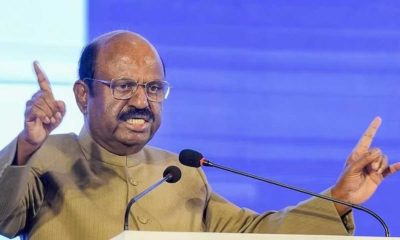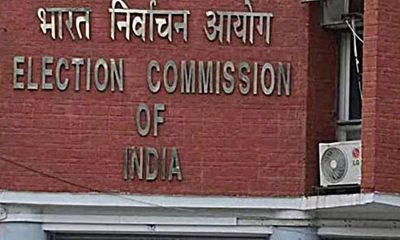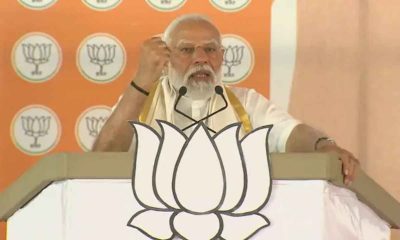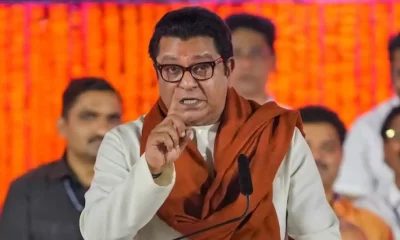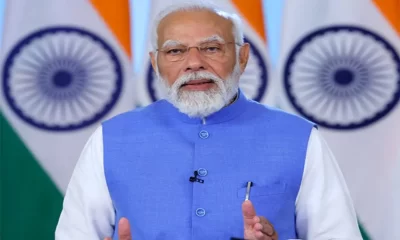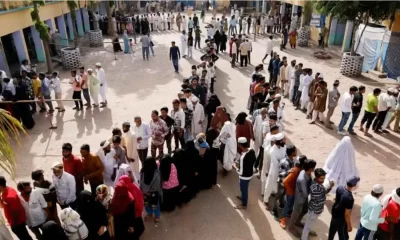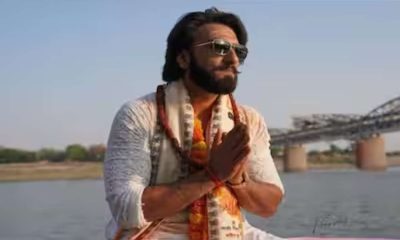Latest Politics News
As India starts voting, what Modi government doesn’t tell you: a report card
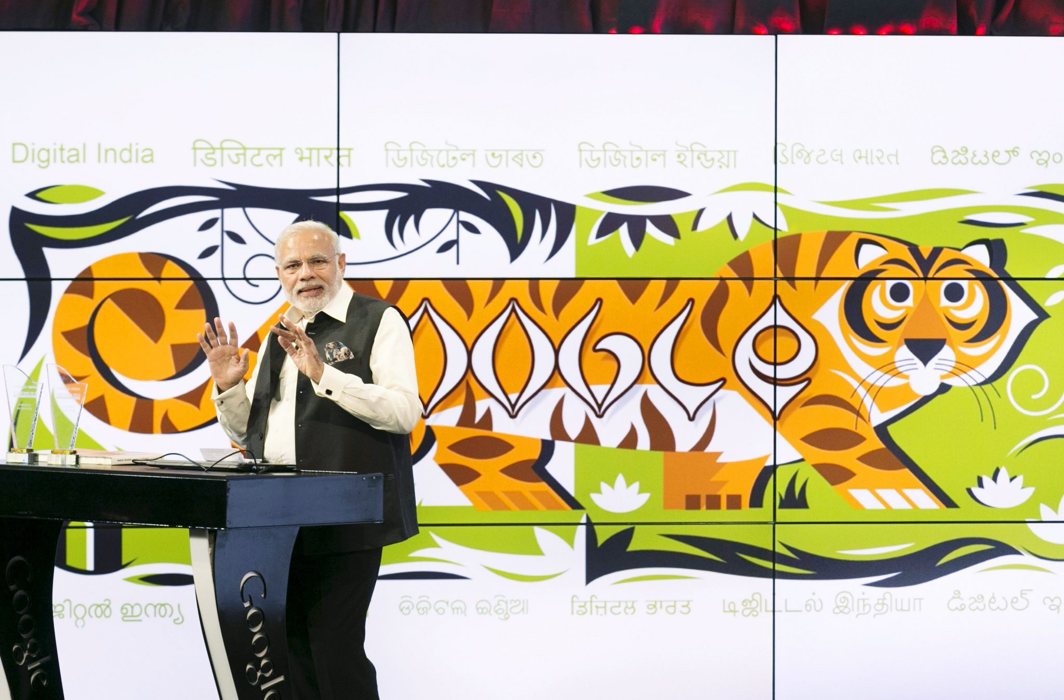
In a sign of the times to come and the things to expect if Prime Minister Narendra Modi wins the elections again, the man has gone around brazenly pushing law, norms and Model Code of Conduct for election to the limits – if not actually defying them – in the election campaign.
He has invoked action taken by armed forces, the bravery and martyrdom of soldiers, Hindu vs Muslim support and deploying all means of communication dubiously to project himself.
On Tuesday, April 9, Modi openly flouted Election Commission of India’s (ECI) orders to refrain from using acts and photographs of armed forces in election campaign to ask for votes in the name of brave soldiers and martyrs at Latur in Maharashtra. The poll officer is reported to have told the Election Commission that prima facie, Modi’s speech violated the Model Code of Conduct.
This came on a day when several former bureaucrats and diplomats were reported to have complained to President Ram Nath Kovind about ECI’s “pusillanimity” in dealing with violations of model code of conduct by BJP and PM Modi.
This was also a day when The Wire ran a report punching holes in the attempts to evade action against NaMo TV, a channel solely devoted to projecting the PM, and showing how it violates the law.
Even earlier, Modi, far from having any compunctions about it, has merrily used official functions for political speeches and campaigns, targeting opposition leaders for “anti-national activities”.
There would be few Prime Ministers in the world whose actions have been directly called into question for violating not just basic norms and morals but the law and model of conduct so blatantly and with such a feeling of impunity as Narendra Modi.
These violations are recent, though fears have been expressed by many academicians, economists, artists, former bureaucrats and armed forced officers, apart from politicians, about institutions of democracy being subverted or compromised to support a government with a rather comprehensive record of under-achievements and failures and a few successes that can be counted on finger tips of one hand.
As veteran journalist Prem Shankar Jha wrote in The Wire, “all he (Modi) has created in the past five years is a factory for the suppression or falsification of economic data.”
Also Read: Election Commission bans release of Modi biopic during elections
The achievements – real and fake – are fed incessantly to people through every conceivable means of communication available, so we shall not go into them. We shall confine ourselves to its shortcomings and failures which would also expose the lies the government, the BJP and its various subsidiaries have been propagating.
National security
First is the Pulwama tragedy, the worst attack in entire history of insurgency in Kashmir, which helped Modi turn back the focus on ‘security’ and ‘Pakistan’, his favourite themes to avoid issues of economic mismanagement, unemployment, agrarian distress and misgovernance, brand the entire opposition as “anti-armed forces, anti-national and pro-Pakistan” and to project himself as the country’s one true patriot.
Writing in a NDTV blogpost, former Finance Minister Yashwant Sinha said: “The Pulwama terror attack was one of the most horrible in the long history of terror attacks in India. Why was such a large convoy of over 2,700 CRPF personnel allowed to travel by road on that fateful day? Why, despite intelligence reports of a possible terror attack, were no steps taken to sanitize the route and prevent such an attack? Why was the mastermind, identified and liquidated within 100 hours of the Pulwama attack, not dealt with earlier? Why was the request of the CRPF to move the troops by air not accepted? These and many others questions which reflect directly and poorly on the functioning of the government of India are not being asked and answered.”
Renowned journalist Prem Shankar Jha wrote in The Wire that the government had received no fewer than three warnings from the Intelligence Bureau and a more detailed one from the Kashmir police warning of the threat of an imminent attack.
Also Read: Rafale deal: SC rejects Modi govt objections, accepts ‘stolen’ documents as evidence
“The golden rule in intelligence analysis all over the world is that for a piece of information to be taken seriously it must be obtained from two independent sources. The pre-Pulwama warning passed the test.
“The CRPF brass, presumably, took the threats seriously, and asked for its jawans to be transported by air instead of sending them by road. It may have also suggested this because heavy snowfall had forced a bunching up of two convoys and was certain to slow their movement to a crawl. But the fact remains that it made the request, and the request was denied.
“Who had the power to deny such a request? In such an important matter, it is unlikely that the Ministry of Home Affairs would have declined on its own. What is more, had it actually done so, the air would have been full of recrimination and denials in the days that followed. But a full month later, there has been only silence. So it is beyond reasonable doubt that the request was denied by the PMO. And that means Modi. Why he would do that, only knows.
This is not the first time Modi has tried to turn mass death into political advantage. Modi was able to use the Godhra fire tragedy and the orchestrated massacres which followed to advance the Gujarat elections by four months, win it and remain the chief minister of Gujarat for the next 12 years. It would have been against his nature not to seize the ‘opportunity’ that the death of CRPF jawans would give him.”
Also Read: Better chance of peace talk with India if BJP wins Election: Imran Khan
While claiming credit for Indian Air Force’s retaliatory strike at Balakot (which he continues to do in violation of election Model Code of Conduct), Modi also jumped to take credit for DRDO’s anti-satellite missile (ASAT) test. While proprietary demanded that in election-time it should have been done by a DRDO official – and this has been pointed out by many – the whole thing appears to have been planned to be timed for elections. The plans became operationalised in the later half of last year and the satellite that was destroyed was reportedly launched in January for the test to happen around this time.
Doklam situation
China’s People’s Liberation Army (PLA) has made significant advances in constructing an ‘all-weather road’ that connects the Doklam plateau with its network of highways. According to latest updates from intelligence sources, a 12-km-long stretch of Merug La-Doklam road has been black-topped and is close to finishing, reported News18 in January this year.
In January 2018, several media reports had highlighted massive Chinese construction of a full-fledged military complex near the disputed plateau area. These reports went on to state that the Chinese were preparing themselves for another Doklam style face-off.
Reacting to these reports, Chinese officials had defiantly remarked, “We will keep building infrastructure in Doklam and India has no business to comment on construction activity on Chinese territory.”
During a US Congressional hearing, in June this year, a top US official stated that China had quietly resumed its activities in Doklam, News18 reported. The US official compared Beijing’s actions in the Himalayan region with their manoeuvres in the disputed South China Sea.
Also Read: Scrapping sedition law: fake propaganda that it is anti-national
Congresswomen Ann Wagner had asked during the hearing, “Although both countries back down, China has quietly resumed its activities in Doklam, and neither Bhutan nor India has sought to dissuade it. China’s activities in the Himalayas remind me of its South China Sea policies. How should our failure to respond to the militarisation of the South China Sea inform the international response to these Himalayan border disputes?”
To this, G Wells, the Principal Deputy Assistant Secretary of State for South and Central Asia, said, “I would assess that India is vigorously defending its northern borders and this is a subject of concern to India… we’re trying to gather likeminded countries who can bring resources to the table, who can coordinate assistance and an effort so as to provide countries with meaningful alternatives.”
India’s rankings in some crucial areas of concern
In rankings of Human Capital Index, evaluating performance on health and education India not only has a very low rank (at 115 among 157 countries), it is even lower than that of two of our poorer neighbours, Nepal and Bangladesh.
In the Social Hostilities Index, brought out by the Pew Research Center for 198 countries, at the end of 2016 India was among the eight worst countries.
In the World Press Freedom Index, brought out by Reporters without Borders, in 2017-18 India’s rank among 180 countries was low, at 138.
In the Rule of Law Index brought out by the World Justice Project for 113 countries, in 2017-18 India’s rank was 62.
In the Report of the Economist Intelligence Unit on the State of Democracy in the World for 2018, India is in the category of “flawed”, not full, democracy; out of 167 countries, India’s rank is 41, worse than Latvia, Taiwan or Botswana — the rank for India having sharply declined compared to 2014.
Claims of development
A report by Mint in the beginning of April this year, citing data from Centre for Monitoring Indian Economy (CMIE) said project announcements declined in the quarter ending March even as the number of stalled private projects reached a record high of 25.4%.
Another report based on CMIE data said the number of investment proposals in India saw the lowest number since 2004-05 in the previous financial year, which ended 31 March.
The CMIE said this lowest figure of new investments recorded in 14 years added up to ‘a dismal’ Rs 9.5 lakh crore.
Also Read: ‘People would seal PM’s lips with Leucoplast’: Mamata Banerjee
The report said last financial (FY18-19) year was the fourth consecutive year of decline in new investment proposals. ‘The estimate of 9.5 lakh crore will be revised upwards in the coming weeks. But, this is unlikely to change the fact that 2018-19 would be the year of very poor investment interest in India,’ said the report. The decline had begun in 2015-16.
The government itself has not fared much better. PM Modi loves to boast that he has not just laid foundation stones, he has also seen the projects through. According to a report prepared by the Ministry of Statistics and Program Implementation, as many as 363 infrastructure projects, each costing more than Rs. 150 crore, have shown a cost overrun of Rs. 3.42 lakh crore.
Of a total of 1,452 delayed projects, 700 did not show even the year of commissioning.
Of the 375 delayed projects, 111 were stalled by one to 12 months, 61 between to 13 to 24 months, 95 between 25 to 60 months and more than 100 projects by 61 months and more.
Wage earners under MGNREGA have not been paid because of the lack of funds, according to a study by the Majdoor Kisan Shakti Sangathan
In other words, in its five years, the government could not complete a single project from the 200-odd it inherited from the previous Congress-led UPA government or which started in its first year since taking power in 2014, pointed out former Finance Minister Yashwant Sinha in a NDTV blogpost.
In the three years between October 2015 and October 2018, credit to the MSME sector declined from 5.9% to 4.5% according to the data released by the RBI.
The wage earners under the Mahatma Gandhi National Rural Employment Guarantee Act (MGNREGA), whose number had shot up steeply after demonetization in November 2016, are suffering as they have not been paid because of the lack of funds, according to a study by the Majdoor Kisan Shakti Sangathan, which also alleged that attempts are being made to willfully cap employment opportunities under the job guarantee Act.
There is a shortfall of at least Rs. 17,000 crore from the wage demand of just the last year.
“A job under this scheme is the last resort for the labourer who picks up work under MGNREGA. It is a crime to hold back his wages,” wrote Yashwant Sinha.
Also Read: BJP releases poll manifesto for 2019 Lok Sabha Elections
The Rs. 95,000-crore scam in the IL&FS group has gone largely unnoticed. The Life Insurance Corporation is the single largest shareholder in this company and so are other government entities like the Central Bank of India and the State Bank of India. This scam took place largely on the government’s watch and it cannot wash its hands of the responsibility as the stakeholders are government companies.
Ujjwala Yojana
This is among the major successes touted by Modi government. This relates to providing gas connections and stoves to poor and is said to have emancipated millions of poor women from unhealthy smoke from ordinary earthen stoves using fuel-wood.
A report by Factchecker found that while gas connections increased 6 percentage points between 2015-16 and 2016-17, LPG consumption increased only marginally (0.8 percentage points) during the same period, Mint reported on June 28, 2017.
Only a few Ujjwala beneficiaries are refilling cylinders, Scroll.in reported on June 11, 2017, citing response from gas agency dealers. BPL families find a refill too expensive after their first connection, the report said.
Even now, anecdotal evidence shows that things have not improved.
Highway construction – most highlighted among infrastructure development
This is often cited by Union ministers and the BJP as evidence of massive improvement in infrastructure under Modi government. However, as in the case of other sector of economy or even the controversy over GDP figures, here too the data is misleading. Media reports last April (Business standard and Hindustan Times) said the government had shifted to new formula to show highway construction in better light.
Now, lane-km has replaced linear length method. This was explained as being in line with international norms and provide a more realistic picture.
For instance if a 14-lane highway is being constructed, the total linear length of the 14 lanes is considered at the time of calculating the length of road built. Earlier, in India whether it was a 4-lane, 6-lane or an 8-lane highway, for example, construction of one kilometre length was considered as total one kilometre.
Going by lane km, the total length of highways constructed during 2017-18 fiscal comes to 34,378 km as against 9829 km if counted linearly.
Jobs
This has been a major shortcoming of the Modi government. The country’s unemployment rate stood at a 45-year high of 6.1% last year (2017-18) according to the National Sample Survey Office’s (NSSO) periodic labour force survey (PLFS) reported by Business Standard (BS).
This is the data which Prime Minister Narendra Modi government has withheld, prompting the two independent members of National Statistical Commission (NSC) – acting chairman PC Mohanan and member JV Meenakshi – to resign.
But apart from the job front, there is a whole range of other government reports and statistics that is usually updated periodically, which Modi government has not made public for years: data on crime, farmer suicides, caste and agricultural wages, found an IndiaSpend research.
Earlier, surveys conducted by the Centre for Monitoring Indian Economy (CMIE) said that 1.1 core jobs were lost last year.
Inconvenient Data withheld
Modi government has kept the country in the dark about several important indicators that are essential for policy making and governance.
Recently, there have also been concerns raised over data going missing from the websites of centrally-sponsored schemes. For example, several sets of data were removed from the Swachh Bharat-Gramin website, including data on expenditure, conversion of insanitary toilets which foster manual scavenging, and several details of toilet construction, as IndiaSpend reported on October 6, 2018.
The accidents and suicides report, which provides information on farmer suicides and is brought out by the National Crime Records Bureau (NCRB), has not been released for four years now.
Data on foreign direct investment, brought out every quarter by the department of industrial policy and production (DIPP), have not been released since June 2018, despite the Reserve Bank of India (RBI) providing it with regular inputs, according to this Business Today report published on January 29, 2019.
When the central government released the socio-economic profile of the population generated through the Socio-Economic Caste Census (SECC) in 2015, it withheld data on caste despite demands from opposition parties and ministers within the government, a report in The Economic Times said in September 2018.
The report of a Comprehensive National Nutrition Survey–started towards the end of 2016 to create comprehensive nutritional profiles of preschoolers (0-4 years), school-age children (5-14 years) and adolescents (15-19 years)–has been ready but not released.
New ideas/schemes
As for ‘innovative’ schemes and ideas by Modi government, an analysis by FactChecker found that Modi has merely renamed 19 out of 23 Congress schemes. It was checking Congress MP Shahsi Tharoor’s claim of June 15, 2017, that 23 of the BJP-led government’s new programmes were merely renamed versions of schemes launched by the previous governments led by his party.
The analysis found that 19 of the 23 programmes were indeed renamed versions of older schemes, as Tharoor claimed.
Here are the renamed schemes with the original nomenclature:
1: Pradhan Mantri Jan Dhan Yojana = Basic Savings Bank Deposit Account
2: Beti Bachao, Beti Padhao Yojana = National Girl Child Day programmes
3: Swach Bharat Abhiyan = Nirmal Bharat Abhiyan
4: Sardar Patel National Urban Housing Mission = Rajiv Awaas Yojana
5: Pradhan Mantri Awaas Yojana (Gramin) = Indira Awaas Yojana
6: Deen Dayal Upadhyay Gram Jyoti Yojana = Rajiv Grameen Vidyutikaran Yojana
7: Atal Mission for Rejuvenation and Urban Transformation = Jawaharlal Nehru National Urban Renewal Mission
8: Pradhan Mantri Krishi Sinchayee Yojana = Accelerated Irrigation Benefits Programme
On this, the analysis said it was not clear if it was a renamed scheme as full details are not available on government websites. Three older programmes – Accelerated Irrigation Benefits Programme of the water resources ministry, Integrated Watershed Management Programme of the land resources ministry and the On Farm Water Management of agriculture and cooperation department – were merged to create the NDA’s Pradhan Mantri Krishi Sinchayee Yojana, according to Yojana’s website.
As government websites do not reveal when exactly the programme was launched in 1996, it is difficult to check this claim, as three prime ministers – Congress’s PV Narasimha Rao (till 16 May), BJP’s Atal Bihari Vajpayee (16 May-1 June) and Janata Dal (Secular)’s HD Deve Gowda (1 June onwards) – governed India during 1996.
The watershed management programme goes back to the late 1980s when the country was mostly under Congress’s rule.
9: BJP’s neem-coated urea = Congress’s neem-coated urea
10: Soil Health Card scheme = National Project on Management of Soil Health and Fertility
11: Paramparagat Krishi Vikas Yojana = Rashtriya Krishi Vikas Yojana and other programmes
12: Pradhan Mantri Matritva Vandana Yojana = Indira Gandhi Matritva Sahyog Yojana
On this, too, it was unclear. The ministry of women and child development’s website does not use the new name –Pradhan Mantri Matritva Vandana Yojana – for the maternity benefit programme but archives releases under the Indira Gandhi Matritva Sahyog Yojana under the same head.
A senior ministry official was quoted as saying the name had been changed, Hindustan Times reported on 25 May 2017.
Also Read: Retired civil servants write to President about Election Commission’s crisis of credibility
13: Atal Pension Yojana = Swavalamban Yojana
14: Pradhan Mantri Jan Aushadhi Yojana = Jan Aushadhi scheme
15: Pradhan Mantri Fasal Bima Yojana = Comprehensive Crop Insurance Scheme
This was found to be false as it did not exist when Modi government assumed office. It was relaunched, but the concept was not new. The 1985 Comprehensive Crop Insurance Scheme concluded in 1999, according to this report of the agriculture and cooperation department.
16: Make In India = National Manufacturing Policy
17: Digital India = National eGovernance Plan
18: Skill India = National Skill Development Programme
19: Mission Indradhanush = Universal Immunisation Programme
20: Deen Dayal Upadhyaya Grameen Kaushalya Yojana = National Rural Livelihood Mission
21: PAHAL = Direct Benefits Transfer for LPG
22: BharatNet = National Optic Fibre Network
23: Sagarmala = National Maritime Development Programme
This was found to be false as the older programme had lapsed. It wasn’t a new concept or original idea, however. The programme was originally announced by Former Prime Minister Atal Behari Vajpayee on 15 August 2003, during the BJP-led NDA’s first stint in power, Frontline reported in March-April 2004.
When the Congress-led UPA came to power, it launched its own National Maritime Development Programme even as Sagarmala lapsed, according to this Lok Sabha answer on 3 August 2009.
The NDA revived the original programme on 25 March 2015.
The Chowkidar and his drive against corruption
Taking Modi’s boast of being a crusader against corruption and #MainBhiChowkidar campaign, apart from the Rafale deal, the IL&FS scam, the favours to Ambani and Adani, another aspect is what it has done to the institutions intended to serve as watchdogs or “chowkidars” of the Indian government.
Lokpal: Modi government was pushed by the Supreme Court into appointing the Lokpal last month. It still has to set up various agencies for investigation and prosecution envisaged under the law.
Judiciary: The Modi government picked fights with the judiciary, particularly over appointments, as soon as it came to power. Until the very end, it tried to pick and choose which judges it wanted to see elevated to higher office. It was also during Modi’s tenure that four senior Supreme Court judges held an unprecedented press conference claiming democracy was at stake because of the conduct of the Chief Justice of India, with murmurs of pressure from the government.
There were also questions around the death of Special CBI Judge BH Loya and the suicide note of former Arunachal Pradesh Chief Minister Kalikho Pul, which had many references to the government and the judiciary.
CBI: India’s premier investigation agency saw infighting like never before as the No 1 and no 2 officers of the CBI. The Centre finally decided to step in, issuing what the Supreme Court later said was a patently illegal, partisan order. The officers involved were eventually moved out, but many threads of their allegations remain, and it is still not clear why this happened on Modi’s watch.
Election Commission of India: The Election Commission, responsible for ensuring free and fair polls, has been under attack not only from opposition parties but has been criticised even by eminent former civil servants who wrote to President complaining about its pusillanimity and crisis of credibility and accusing it of acting in a partisan manner in favour of the BJP.
Also Read: PM Modi appeal to dedicate votes to soldiers is prima facie violation of poll code: Poll officer
This was not the only time the Election Commission was questioned for taking a view perceived as favourable to the Centre, including most prominently in deciding the dates for elections – as in the case of Gujarat elections.
Central Information Commission: The Right to Information Act literally empowers every Indian citizen to be a “chowkidar”. So naturally, the current government sought to amend the law, making changes that activists said would clearly dilute it. The government eventually backed down in the face of public pressure. It has also consistently run the commission under-staffed, which many have argued is a way of diluting the RTI act, even without amending it.
Reserve Bank of India: The central bank is the custodian of the economy, meant to ensure that it takes a longer view of economic decision-making than the government of the day. Under Modi, the Reserve Bank of India saw the first resignation of a sitting governor since the 1950s, and the suggestion that the government may pull out the never-before-used Section 7 of the RBI Act to force the central bank into doing things, including handing money over to the Centre.
Rajya Sabha: In some ways, the Rajya Sabha exists to keep a check on the Lok Sabha, particularly on behalf of the states. It is meant to ensure that legislation cannot be bulldozed through Parliament by a brute majority. However, the Modi government has repeatedly made efforts to bypass the upper house. Early on, Finance Minister Arun Jaitley gave many lectures about how the “unelected” Rajya Sabha could have the temerity to question the other House. But later, the government simply decided to put its controversial legislative decisions into Money Bills that bypass the Rajya Sabha.
2024 Lok Sabha Elections
Lok Sabha Elections: Voter turnout 62.02% in Tamil Nadu till 5pm
The voter turnout in Tamil Nadu stands at 62.02%, while Uttar Pradesh records a turnout of 57.5%. Meanwhile, in West Bengal, voter participation surges to 77.5% as of 5 pm.

The Lok Sabha elections 2024 began today, marking the onset of the world’s largest electoral event. Voting ended in all 39 Lok Sabha constituencies in Tamil Nadu with a total voter turnout of 62.02%. State BJP chief and Coimbatore Lok Sabha constituency candidate K Annamalai said, they were getting complaints from a large number of voters that their names were missing from the voters’ list.
This incident happened in many places. Annamalai said they are demanding re-poll in places where the names of a large number of voters were missing.He said they had a doubt that there was some political interference because the names of a large number of BJP caders were missing from the voters list.
The voters in South Chennai showed lukewarm interest to participate in the election process and had a total voter turnout of 57.04% till 5pm. Although the overall percentage is poor, some areas like Thiruvanmiyur witnessed brisk polling from 7am onwards. Elderly, middle aged and young voters turned up and it was a family outing for many as they cast their vote.
Corporation volunteers assisted senior citizens with wheelchairs and guided them to their respective polling booths. The hot weather also had an impact on the polling as it reduced the voter turnout as many booths in the corporation school in MGR Nagar were seen deserted around noon. Senior citizens showed courage as they reached the polling booths in private vehicles to exercise their franchise.
Most of the polling booths had shamianas for voters so that they could wait in a queue. Some people even found refuge in the nearby buildings to save themselves from the scorching heat. The polling officials gave instructions to the voters to keep their phones switched off while they exercised their franchise. The security personnel at the polling booth also regulated traffic outside the polling booth in MGR Nagar.
2024 Lok Sabha Elections
Deserted by key supporters, the Kamal Nath story looks set to wind to an end in Chhindwara
Nath’s closest allies in his near 50-year reign—Deepak Saxena and Kamlesh Shah—have deserted him. His local team of corporators has also decided to jump ship leaving a gaping hole in Nath’s campaign trail.

By Neeraj Mishra
The Congress has lost Chhindwara only once since Independence when the wily Sunderlal Patwa was sent there by Atal Bihari Vajpayee to test Kamal Nath’s hold on the constituency. Patwa won the 1997 by-election by a slim margin in the backdrop of Nath having forced his wife to first contest and later vacate the seat for him. Nath, however, returned to his winning ways the very next year and has won the seat nine times.
It seems possible that Chhindwara, the lone surviving Congress seat, will be lost again this time and may be forever. A day ahead of polling, the town was drowned in saffron. Not so much the effect of vigorous campaigning by Vivek Sahu of the BJP but the Ram Navami festival which brought out saffron flags on every rooftop. The effect is likely to last since the polling is today. At 77, Nath is unlikely to contest another election here and his son Nakul seems like a pale shadow of his father unable to even make a forceful speech. The days of running Chhindwara from Shikarpur kothi are gone.
Nath’s closest allies in his near 50-year reign—Deepak Saxena and Kamlesh Shah—have deserted him. His local team of corporators has also decided to jump ship leaving a gaping hole in Nath’s campaign trail. Nakul had won by a margin of 37,000 votes in 2019 and the biggest lead had come from Kamlesh’s Amarwada Assembly segment. With Saxena in control of Chhindwara and forced to show his strength in his new party, it is highly likely that Nakul will not be depending on these segments. Instead, the Congress campaign was focused on Pandhurna, Parasia and Chaurai.
Amit Shah was in the region a couple of days ago and warned all BJP workers—old and new—against lethargy. His message was clear, the BJP wants all 29 seats this time. Cabinet Minister Kailash Vijayvargiya is camped here and using all his political acumen for the desired results. One such tactic was to raid the Shikarpur Kothi of Kamal Nath for his assistant Miglani who handles almost everything for him. With Miglani temporarily neutralised, BJP is best placed to repeat its win in Chhindwara in 1997.
2024 Lok Sabha Elections
Lok Sabha elections 2024: Amit Shah files nomination from Gandhinagar
The Union Home Minister Amit Shah was accompanied by Gujarat CM Bhupendra Patel.
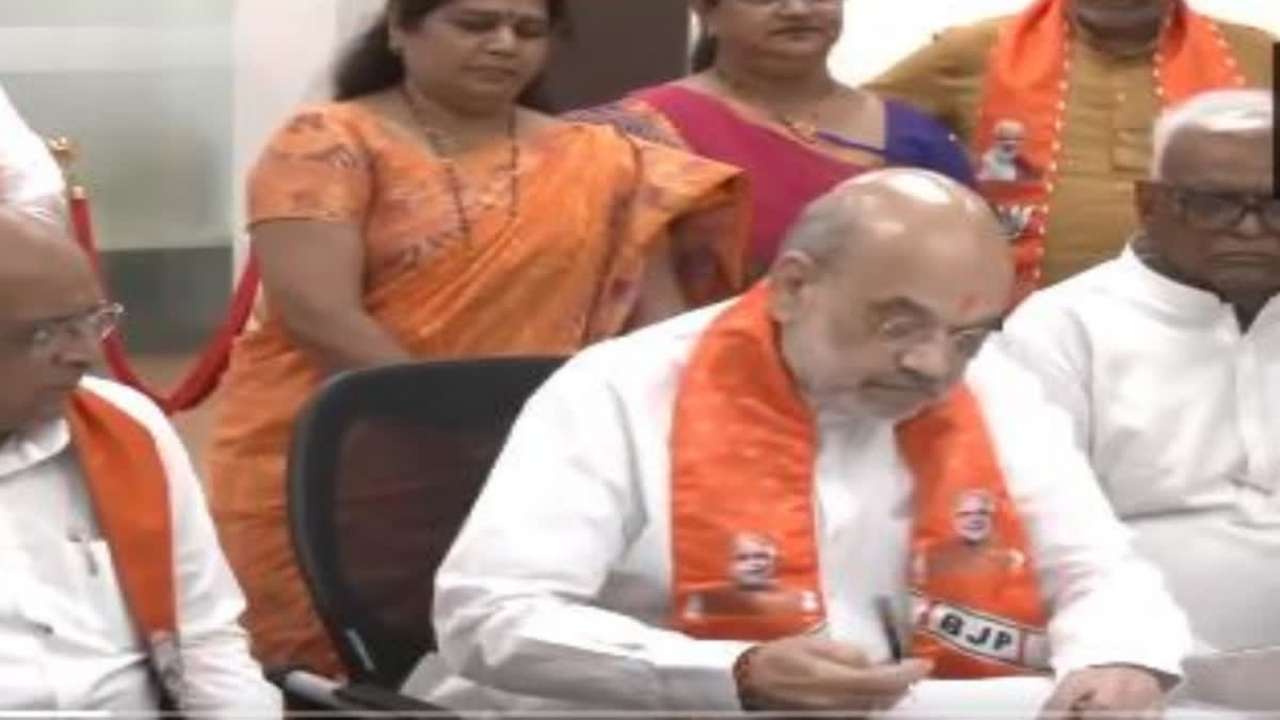
Ahead of the upcoming general elections, the Union Home Minister Amit Shah submitted his nomination today from Gandhinagar Lok Sabha constituency. During his nomination, Gujarat Chief Minister Bhuperndra Patel accompained him.
Former deputy prime minister and BJP chief LK Advani, who earlier served as a representative of this seat during Shah’s successful run for re-election.
Soon after filing nomination, Shah said, today he has submitted his nomination from the Gandhinagar seat. He said it is a matter of pride for him that this seat was represented by the former Prime Minister Atal Bihari Vajpayee, LK Advani and the seat where Narendra Modi himself is a voter. He also said he has been an MLA and MP from this seat for 30 years. The people of this region have given him immense love, Shah said.
With an astounding vote share of 69.67 percent in the 2019 Lok Sabha elections, Shah maintained the BJP’s stronghold in Gandhinagar with a resounding victory. Election turnout has been consistently high in the city.
In 1984–85, Amit Shah joined the BJP. His political skills and organizational prowess were recognized, and he soon became the national treasurer of the Bhartiya Janata Yuva Morcha.
Amit Shah’s political career took a significant turn in 1991.
Shah became the national president of the BJP in 2014, and he was promoted to the position of Home Minister five years later.
In the context of Indian politics, Gandhinagar is a historical landmark. The former prime minister Atal Bihari Vajpayee, won seats from Gandhinagar and Lucknow in the 1996 Lok Sabha elections. However, he decided to stay to his Lucknow seat, opening the door for other leaders to set their mark in Gandhinagar.
Meanwhile, Congress has fielded its party secretary Sonal Patel from Gandhinagar.
Gujarat is scheduled to go for a single phase of elections on May 7. The results of the election will be announced on June 4.
-
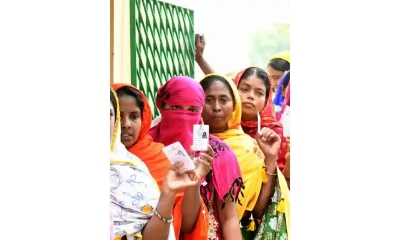
 2024 Lok Sabha Elections23 hours ago
2024 Lok Sabha Elections23 hours agoPrime Minister Narendra Modi urges citizens to vote in record numbers as voting for first phase of Lok Sabha elections begins on 102 seats across India
-

 Entertainment18 hours ago
Entertainment18 hours agoDo Aur Do Pyaar social media review: Social media users say Vidya Balan, Pratik Gandhi deliver standout performances in this adorable film
-
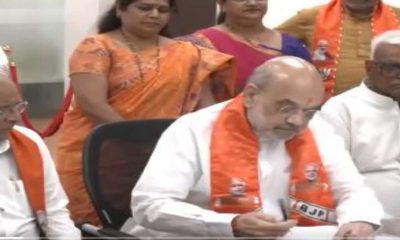
 2024 Lok Sabha Elections19 hours ago
2024 Lok Sabha Elections19 hours agoLok Sabha elections 2024: Amit Shah files nomination from Gandhinagar
-

 Entertainment19 hours ago
Entertainment19 hours agoYami Gautam starrer Article 370 releases on Netflix today
-
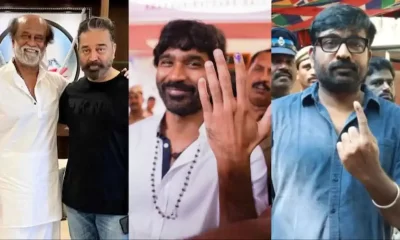
 2024 Lok Sabha Elections21 hours ago
2024 Lok Sabha Elections21 hours agoKamal Haasan, Rajinikanth, Vijay Sethupathi, Dhanush vote in Chennai
-

 2024 Lok Sabha Elections14 hours ago
2024 Lok Sabha Elections14 hours agoDeserted by key supporters, the Kamal Nath story looks set to wind to an end in Chhindwara
-

 2024 Lok Sabha Elections21 hours ago
2024 Lok Sabha Elections21 hours agoLok Sabha elections 2024: TMC, BJP workers clash in West Bengal’s Cooh Behar ahead of voting
-

 Entertainment16 hours ago
Entertainment16 hours agoAditya Roy Kapur, Sara Ali Khan’s Metro In Dino to release this November

